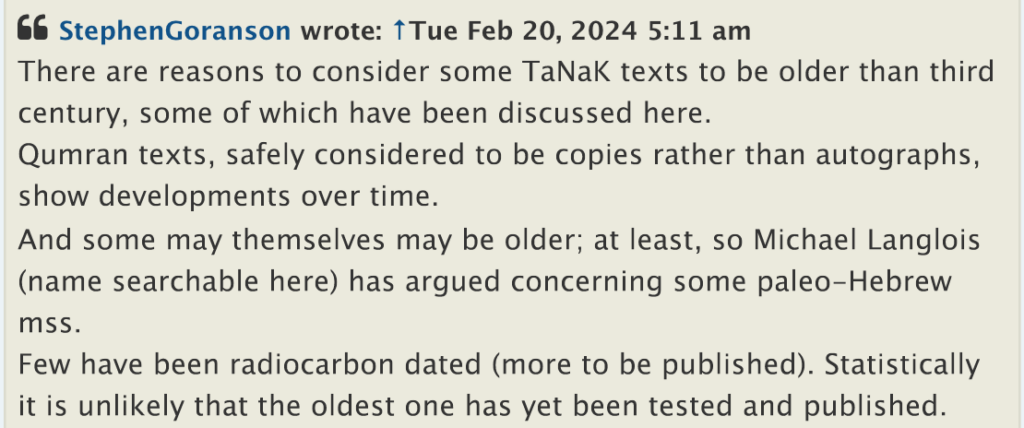I am posting here on my blog what I had posted in the “Academic Discussion” of the EarlyWritings Biblical Criticism & History Forum and I hope soon to post specific criticisms or responses that were made in that space. I am collating both those criticisms and my own responses as far as I can find them to make them all accessible here. The reason for doing this is that on that forum some of my comments were removed (without notifying me) to other places outside the Academic Discussion area and replies made to them without my being aware of what was going on. To the extent I have tracked those down I will post them here. (I may have more to say about the range of discussion that is permitted on that forum — and enforced by means of ridicule and insult directed at those who dare to question the fundamentals of core biblical studies models and methods.) I will, of course, also be posting other scholarly arguments that have been used to date the books of the Hebrew Bible to the Persian period and earlier.
Here is one of the earlier criticisms. It is from Stephen Goranson:
My reply (originally posted on the earlywritings forum):
Michael Langlois has the scholarly professionalism to acknowledge when others have interpretations that differ from his own, noting what is possible outside his own preferences and where another specialist has disagreed with him.
He writes in relation to 4Q46 (p. 270):
4Q46 would thus be at home in the fifth or fourth centuries BCE; an earlier date is not impossible but lacks clear parallels, whereas a date in the third century is possible but unnecessary.
In relation to 4Q12: (p. 271):
. . . would also be at home in the fifth or fourth centuries BCE, perhaps in the third century should the development of the script be slow. McLean dates 4Q12 to the “middle of the second century” BCE; 64 such a late date is unnecessary.
On 2Q5 (p. 271)
. . . this manuscript could be at home in the fourth or third centuries. McLean dates it to ca. “150 to 75 BCE” 65 which seems unnecessarily late.
On 6Q2 (p. 271)
Overall, 6Q2 may also have been copied around the fourth or third centuries BCE. McLean acknowledges the affinities between 6Q2 and 2Q5 and ascribes them both the same unnecessarily late date between 150 and 75 BCE.
On the 1Q3 fragments (p. 272)
Although a date in the fourth century is possible, 1Q3 is probably more at home in the third century, like 4Q11. McLeanʼs dating between “150 to 75 BCE” 67 is, once again, probably late, while Birnbaumʼs dating “ca. 440 B.C.E.” 68 is too early, flawed by his methodology.
And on the 6Q1 fragments (p. 272)
… may have been copied around the third century BCE. McLean dates 4Q101 “between 225 and 150 BCE,” 69 and 6Q1 and 4Q123 to the “last half of the second century” BCE 70 ; these ranges are possible but too narrow and a bit late.
- Langlois, Michael. “Dead Sea Scrolls Palaeography and the Samaritan Pentateuch.” In The Samaritan Pentateuch and the Dead Sea Scrolls, edited by Michaël Langlois, 255–85. Contributions to Biblical Exegesis and Theology 94. Leuven ; Bristol, CT: Peeters, 2019.
As has been noted elsewhere [in earlier discussions on the Early Writings Forum], Langlois “does not point to any palaeographic feature that positively indicates a 5th or 4th century as opposed to third century BCE date”.

